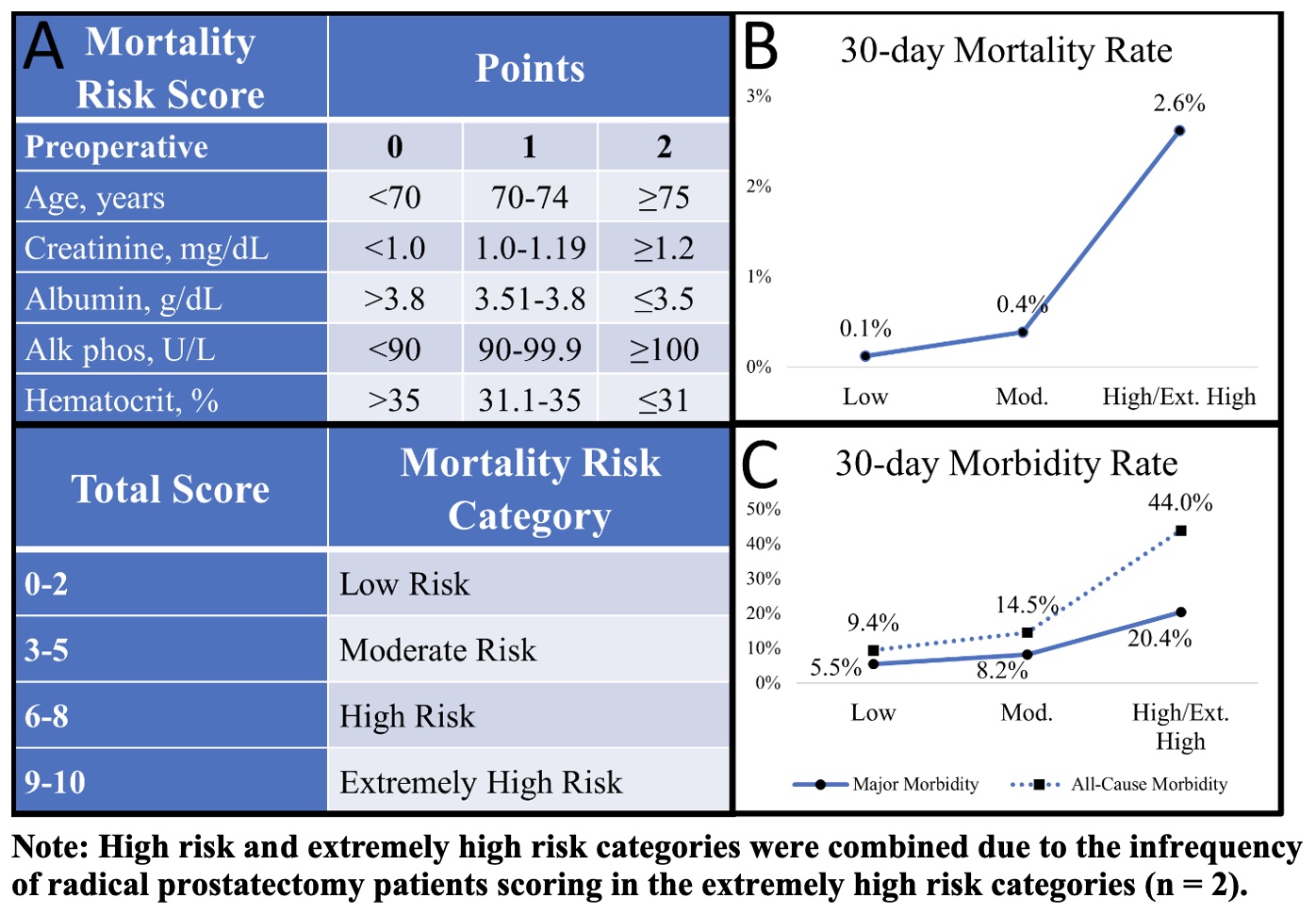Back
Poster, Podium & Video Sessions
Podium
PD60: Prostate Cancer: Localized: Surgical Therapy V
PD60-07: Objective Risk Score Reliably Predicts Major Morbidity and Mortality after Radical Prostatectomy
Monday, May 16, 2022
2:00 PM – 2:10 PM
Location: Room 245
Kristen Maatman*, Christopher Ledbetter, A. Lynn Patterson, Robert Wake, Memphis, TN
- KM
Podium Presenter(s)
Introduction: Radical prostatectomy (RP) is the gold-standard treatment for localized prostate cancer. We have previously developed and validated a 30-day mortality risk score after radical cystectomy and radical nephrectomy and hypothesized that this risk score could be applied to patients undergoing RP for prostate cancer.
Methods: The National Surgical Quality Improvement Program (NSQIP) identified 48,285 patients that underwent RP for malignancy from 2014-2018. Only patients with complete data for risk score calculation were included in this analysis. Risk factors for 30-day mortality were identified on multivariable analysis using backward stepwise binary logistic regression. A previously developed and validated mortality risk score (Figure 1A) was calculated for each patient undergoing RP. A receiver operating characteristic (ROC) curve was created to quantify the discriminatory ability of the risk calculator. P values < 0.05 were accepted as statistically significant. The primary aim of this study was to stratify the risk of 30-day mortality after RP; secondary aims included risk stratification of major morbidity and all-cause morbidity.
Results: 17,699 RP patients were included. Most underwent robotic assisted laparoscopic prostatectomy (89%, n = 15,695). Mean age was 62±7 years. Rates of 30-day major morbidity and all-cause morbidity were 6.0% and 10.6%, respectively. Postoperative 30-day mortality was 0.19% (n = 34). Multivariable analysis associated chronic obstructive pulmonary disorder, lower albumin and hematocrit, and elevated alkaline phosphatase with 30-day mortality (p < 0.05). After RP 30-day mortality increased exponentially with escalating risk category (Figure 1B). The area under the ROC curve for the mortality risk score in patients that underwent RP was 0.702 (95% CI, 0.609-0.796; p < 0.0001). The risk score additionally stratified the risk of 30-day major morbidity (AUC, 0.867; 95% CI, 0.788-0.947; p < 0.0001) and all-cause morbidity (AUC, 0.860; 95% CI, 0.785-0.934; p < 0.0001) after RP (Figure 1C).
Conclusions: A previously established mortality risk score can be employed in patients undergoing RP for prostate cancer to stratify 30-day mortality risk as well as risk of major morbidity. This risk score is reliable, accurate, and applicable to both minimally invasive and open RP.
Source of Funding: None

Methods: The National Surgical Quality Improvement Program (NSQIP) identified 48,285 patients that underwent RP for malignancy from 2014-2018. Only patients with complete data for risk score calculation were included in this analysis. Risk factors for 30-day mortality were identified on multivariable analysis using backward stepwise binary logistic regression. A previously developed and validated mortality risk score (Figure 1A) was calculated for each patient undergoing RP. A receiver operating characteristic (ROC) curve was created to quantify the discriminatory ability of the risk calculator. P values < 0.05 were accepted as statistically significant. The primary aim of this study was to stratify the risk of 30-day mortality after RP; secondary aims included risk stratification of major morbidity and all-cause morbidity.
Results: 17,699 RP patients were included. Most underwent robotic assisted laparoscopic prostatectomy (89%, n = 15,695). Mean age was 62±7 years. Rates of 30-day major morbidity and all-cause morbidity were 6.0% and 10.6%, respectively. Postoperative 30-day mortality was 0.19% (n = 34). Multivariable analysis associated chronic obstructive pulmonary disorder, lower albumin and hematocrit, and elevated alkaline phosphatase with 30-day mortality (p < 0.05). After RP 30-day mortality increased exponentially with escalating risk category (Figure 1B). The area under the ROC curve for the mortality risk score in patients that underwent RP was 0.702 (95% CI, 0.609-0.796; p < 0.0001). The risk score additionally stratified the risk of 30-day major morbidity (AUC, 0.867; 95% CI, 0.788-0.947; p < 0.0001) and all-cause morbidity (AUC, 0.860; 95% CI, 0.785-0.934; p < 0.0001) after RP (Figure 1C).
Conclusions: A previously established mortality risk score can be employed in patients undergoing RP for prostate cancer to stratify 30-day mortality risk as well as risk of major morbidity. This risk score is reliable, accurate, and applicable to both minimally invasive and open RP.
Source of Funding: None


.jpg)
.jpg)